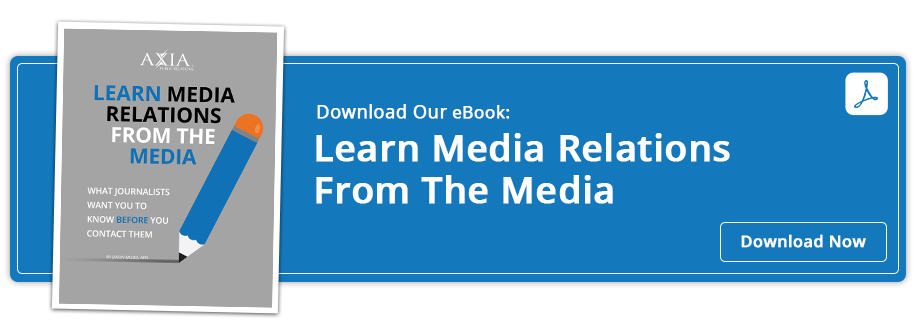Highlight the currency of your media pitches to interest journalists.
 When you consume news, you may notice a pattern: Most news is timely. Likely, you prefer to hear about events that happened recently — the more current, the more interesting. This is called timeliness, and it’s one of the most important pillars of newsworthiness.
When you consume news, you may notice a pattern: Most news is timely. Likely, you prefer to hear about events that happened recently — the more current, the more interesting. This is called timeliness, and it’s one of the most important pillars of newsworthiness.
Audio: Listen to this article.
Journalists build news stories on a foundation of elements called news values, which contribute to a story’s newsworthiness. One story is more newsworthy than another if more readers will care about it. Journalists consider news values (like timeliness) when they search for story ideas. As a public relations, corporate communications, or marketing professional pitching to journalists, you must work news values into your pitches.
What makes a news pitch timely?
A story that requires timeliness will lose its impact over time. Breaking news stories are a great example of timely stories, and they almost always leverage the timeliness news value.
This June 6 NPR story about gas prices is a great example of timeliness. The story was timely and accurate on June 6, but when you read this blog post, gas prices have likely changed, making the story no longer timely. You’ll probably care more about a story that’s more current or relevant.
To assess whether your story depends on timeliness, ask yourself, “Will this story matter tomorrow? Will it matter in a week? In a month?” The answer won’t always be “No” — some stories do not lose their value over time, and those stories likely use many other news values.
Remember: News is usually “what’s new” and “what’s next.” Something that happened last week, last month, or last year is not news because it is not timely.
How to leverage timeliness
Timeliness is not a one-size-fits-all factor to work with. Different stories demand different ways of using timeliness effectively, as these examples highlight:
- Pre-event stories
Some stories lose their impact after an event takes place. These stories are often meant to inform audiences about the event so they can anticipate and prepare for it accordingly. People want to know about these events before they happen or as they’re happening. The Wall Street Journal published this story Jan. 8 about the U.S. preparing $10 billion in aid for small businesses. The story said the government expected to begin distributing the money in the first quarter of 2022. This story was published at the beginning of the 2022 first quarter, making it timely — those small companies wanted to know about the aid before they received it so they could plan how to use it.
Election-preparation stories are another great example of this: The Associated Press published this story the day before seven states held primary elections, giving information about what was at stake in the elections and who was running. You’ll notice the story says the day of the upcoming election in the first sentence. That tells the reader right away, “This story is newsworthy. Read it!”
When pitching to journalists, let them know how and why the story is newsworthy by leading with the newsworthy elements — in this case, the “when” of the future event.
- Post-event stories
Post-event stories take a different timeliness angle than pre-event stories, usually recapping or analyzing an event. Remember: The more recent, the better. The Washington Post published this story about Apple’s developer show on June 6 immediately after the event, making it a timely story that audiences would have interest in reading. The first sentence tells us when the developer show was, helping us see the timeliness value right away. Two paragraphs later, the story mentions a future event as well — when Apple will release the new products and features — which adds another element of timeliness.
To earn post-event media coverage for your brand’s events, you don’t have to wait until the event passes to write a news release to pitch to journalists. Instead of writing the news release “for immediate release,” you can write at the top, “under embargo until,” and include the event date and time. This tells journalists they can write the story ahead of time, but they shouldn’t publish it until after the “embargo” date and time. Writing news releases ahead of time under embargo can give you a head start on making your story pitches timely, but make sure you have an established relationship with a newsroom before sending it news releases under embargo. Journalists do not have to honor your embargo request and can publish the story before the embargo date if they want to. It’s up to you to decide which newsrooms you trust with confidential information.
Must Read: What journalists say about media pitches and sources
Timeliness isn’t always enough
As with all news values, having just one might not be enough to sell journalists or audiences on your story. Try to incorporate at least three to five news elements in your story pitches, and remember to lead with the news.
It’s also important to remember that not all stories have to be timely. They should be most of the time, but it’s not an absolute. For example, events involving oddity, human interest, or extremes may still capture attention far after they happen.
To bring your media pitches to the next level, learn about more news values you can include to capture journalists’ attention. You can also download our e-book “Learn Media Relations from the Media” to learn how to strengthen your relationship with journalists.
Photo by JESHOOTS.com from Pexels
Topics: media relations, earned media, news media


Comment on This Article